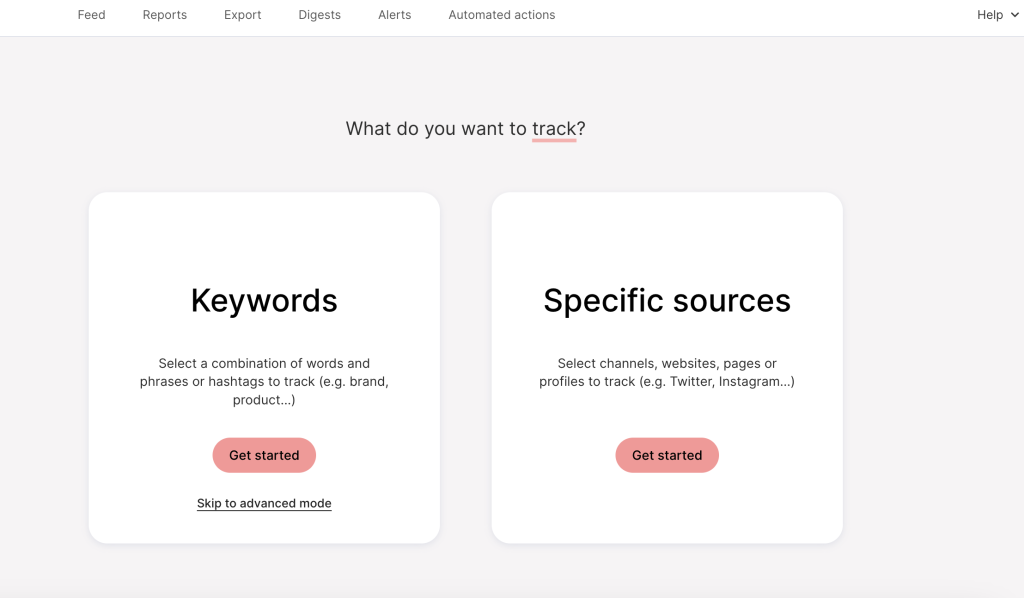Finally decided that you should stay on top of your brand’s online presence?
Congratulations! Now it’s time to choose your reliable ally in the process – a corresponding media monitoring tool.
Both BrandMentions and Determ are among the most famous ones, but how to choose the one which fits your business needs better?
In this blog post, we’ll be taking a deep dive into BrandMentions and Determ, comparing their features, user experience, pricing, and overall value to help you determine which tool is right for you. So, whether you’re a small business owner looking to improve your online reputation or an agency/ a bigger company trying to stay ahead of the competition, read on to learn more about BrandMentions and Determ and which one might be the best fit for your needs.
Features
When it comes to selecting a media monitoring tool, what usually directs the whole decision-making process are specific features. So when choosing your media monitoring tool, start from the basics. Which scope of work do you think a media monitoring tool should cover? Which of the functionalities do you need? What is the best value for money you can get? And ultimately, which of the tools’ functionalities align with your goals and plans for growth?
These are some of the questions you need to ask yourself.
Let’s take a look at what BrandMentions and Determ have to offer and how they differ – features-wise.
Sources
Determ tracks over 100 million online sources, and these are:
- Facebook,
- Twitter,
- Instagram,
- Youtube,
- News
- Reddit,
- Tripadvisor,
- Websites,
- Blogs,
- Comments,
- and Forums.
BrandMentions tracks:
- Facebook,
- Instagram,
- Twitter,
- News,
- Reddit,
- Linkedin,
- Quora,
- YouTube,
- Reviews,
- And Pinterest.
Though BrandMentions tracks some of the sources that Determ doesn’t, it still doesn’t have the ability to track blogs, forums, and comments which Determ has, and there is a limit to the number of keywords you can track. Determ, on the other hand, offers an unlimited number of keywords and provides real-time updates of mentions on all plans.
Read How to Get Started With Real-Time News Tracking?
Boolean Operators
Determ has the option of an advanced search using Boolean operators. They are simple words (like AND, OR, AND NOT, etc.) that are used as conjunctions to narrow down your search.
So let’s say you’re interested in the mentions of an Adidas campaign featuring their brand ambassador Kendall Jenner. You’ll use the operator AND or NEAR and get all relevant mentions of the 2 keywords in the same context, which you can then analyze.

There is an abundance of Boolean operators you can use in your Determ query setup, enabling you to include different variations of the words, to determine a wider or narrower context, group or exclude mentions, etc.
BrandMentions offers a similar advanced search, but the choice of the Boolean operators you can use is much smaller, and the options to target precisely what you need are, therefore, somewhat slimmer.
Alerts
Alerts are notifications that you can set up in your media monitoring tool. They are triggered whenever the keyword you’re tracking is mentioned online, and with Determ you can get them in real-time.
Determ delivers these notifications in 3 ways – through Slack, email, or mobile app. To top it all, this feature is available on all plans, and there are no limitations to the number of alerts you can set up and receive. Worth mentioning – you can track 107 languages in 250 locations.
Read 5 Benefits of Real Time Alerts for Your Brand

BrandMentions also has the alerts feature, but with certain limitations. It doesn’t have a mobile application, so there you can receive them only through email or Slack.
Influencers
Both BrandMentions and Determ provide a list of top influencers.
These are online media, social media users, and profiles that are considered to be the advocates for a certain term (brand, product, campaign, etc.). Besides giving the list of these online media outlets, Determ offers the possibility to rank them by sentiment, source, engagement, reach, etc. In this way, you can easily compare the lists and take the one that suits you the best at a given moment, depending on the use case.
Read B2B Influencer Marketing: How To Find Top Niche Influencers
If you’re, for example, using the tool for crisis management, you’ll take the list of influencers by sentiment and focus on the negative ones. If you’d like to explore potential partnerships with media outlets that have a high reach, you’ll take a look at the influencers by reach list mentioning your queries.

BrandMentions influencers feature looks like this:

AI
Determ has a powerful AI assistant called Synthia. Synthia has the ability to:
- understand the wider context
- easily identify sentiment and tone of voice
- anlyze any spoken language and give actionable insights
The entire summary by Synthia is available in a matter of seconds and it speeds up your processes and saves time and money.

BrandMentions doesn’t offer a similar feature.
Historical data
Determ and BrandMentions both offer a great amount of historical data. BrandMentions offers historical data from 6 months to up to 10 years ago. Determ, on the other hand, offers from 1 up to 24 months, but if you need more, it’s available on demand.
Demographics
Demographical data are extremely valuable in any kind of marketing or PR research. The reason is quite simple – they add an extra dimension to the understanding of your other data.
Read New in Determ: Demographics by Gender
But what do demographical data actually include?
It’s information about specific groups of people according to attributes like age, gender, place of residence, various socioeconomic factors like occupation, family status, etc.
With Determ you have access to demographic information on gender, to be more precise:
- Percentage Of Sentiment Per Gender
- Gender Distribution
- Percentage Of Gender Per Sentiment
- Mentions Over Time (Per Gender)
- Locations (Male And Female)
- Word Cloud (Male and Female)
- Emoji Cloud (Male and Female).

BrandMentions doesn’t offer any demographical data in their reports.
Data export
Determ has three types of predefined reports, and they are available on all pricing plans – basic, advanced and competitive. The demographics report is available on the highest pricing plans.
What is more, you can create an unlimited number of reports in all plans. Additionally, you can also download specific sections of reports or the whole report in PDF. Or you can download it as an editable document ready for customization (PPT).
Finally, you can create a custom dashboard (available on higher pricing plans) or create a branded report which you can edit with your logo and colors.
Read Exports: How To Save Your Media Monitoring Data

BrandMentions, on the other hand, offers similar types of reports, but with significantly fewer exporting options (you can’t export in Word or PPT, and there are no email mention report exports). Also there is no option to download an individual chart from the report.
Automated actions
Automated actions are a feature that helps you group your mentions, segment it in a specific way, filter and analyze separately. They function on the basis of predefined conditions that you can set up in your account. And when a mention includes a particular keyword or comes from a specific source, they add a tag to it or set a specific sentiment.
For example, if you’d like to learn more about what your customers complain about, you can set the tool to assign a “negative feedback” tag whenever a mention contains the keywords: bad, terrible, disappointing, unfriendly, etc. This will allow you to filter your feed and focus only on the mentions that express criticism.
Determ offers both adding a tag and sentiment to a mention, without any limitations.
When it comes to automation, BrandMentions doesn’t offer tag nor sentiment adding.
Read Automated Actions: Effortlessly Assign Tags and Sentiment

User experience
Apart from the features, one of the most important aspects when choosing a corresponding media monitoring tool is the ease of use and the overall user experience.
How user-friendly are Determ and BrandMentions?
Let’s take a look.
Setting up your first query
Registering to both tools is extremely simple. You can create your account in a couple of minutes and check out how each respective platform works.
After logging in to your Determ account, you’re led to a dashboard that allows you to create your first query:

This dashboard allows you to focus immediately on tracking specific keywords (your brand name, competitors, key people, etc.) or a particular source (like website, or a specific social media profile).
After this step, you can narrow down your search additionally, if you want, by choosing filters like language, location, authors, etc.
Once you’re done setting up your query, you’ll be led to a very clean dashboard:

The dashboard will show you a list of mentions, and on the right side you can focus your search on different sources, sentiments, tags, or you can filter your feed by reach, language, virality, etc.
There’s an additional cool feature of the tool – every time you come back to the tool after this initial setup, you’ll be led to a home page, where you can take a look at a quick overview of the mentions for a specific query, and basic metrics.

BrandMentions dashboard segments the data in a bit of a different way. The focus isn’t on the mentions that much, it’s more on the metrics.

Customer Support
Both Determ and BrandMentions have customer support available by email, chat or phone, they both offer training materials, a knowledge base and a dedicated Customer Success Manager on higher pricing plans.
But though they both provide excellent customer service, Determ’s support is one of its main strengths. And judging by the reviews on G2, with a score of 9.7 it’s really hard to beat. The quality of customer support in Determ is of utmost importance, and to make sure that their customers are satisfied they offer guided onboardings on higher pricing plans.
Mobile App
Determ has a mobile application compatible with iOS and Android devices.
Determ app allows you to set up real-time notifications about your brand mentions. These can be sent to your email inbox or Slack. Additionally, you can add new queries and track recent mentions. You can also have an overview of basic reports from the app interface.

BrandMentions doesn’t offer a mobile application.
To Conclude
BrandMentions and Determ are media monitoring solutions geared towards small and medium businesses. Both offer a great deal of features for users to monitor, alert, and report key information about their brand online.
The key differences between Brand24 and Determ are their search, monitoring, and reporting capabilities.
When comparing the two, Determ offers more flexibility and data with:
- Unlimited keywords on all plans
- All tracked sources and filters available on all plans.
Moreover, Determ has a stronger suite of analysis, reporting, and exporting options and it custom-tailors its pricing to their customers’ needs.
Determ is a more complete solution that offers greater value for money on all paid plans at a lower price, with a mobile app for monitoring and alerting on the go. If you want us to show you its value for your business and give it a try, book a demo – we’d be happy to show you around.






